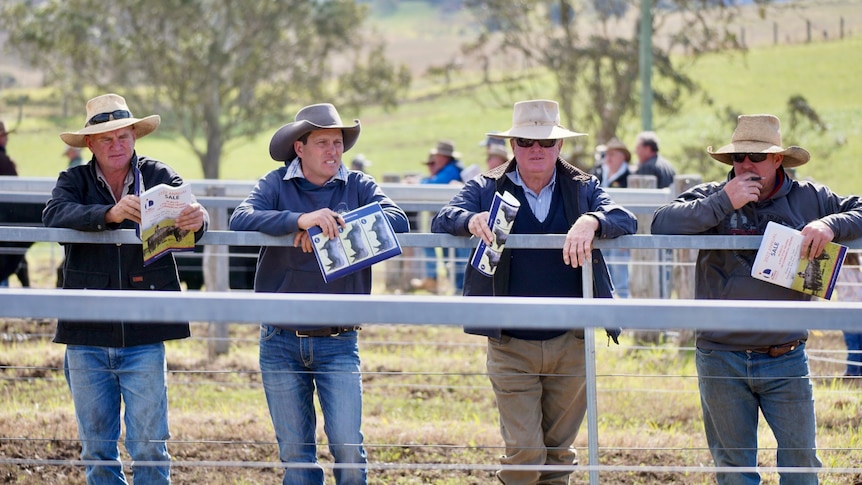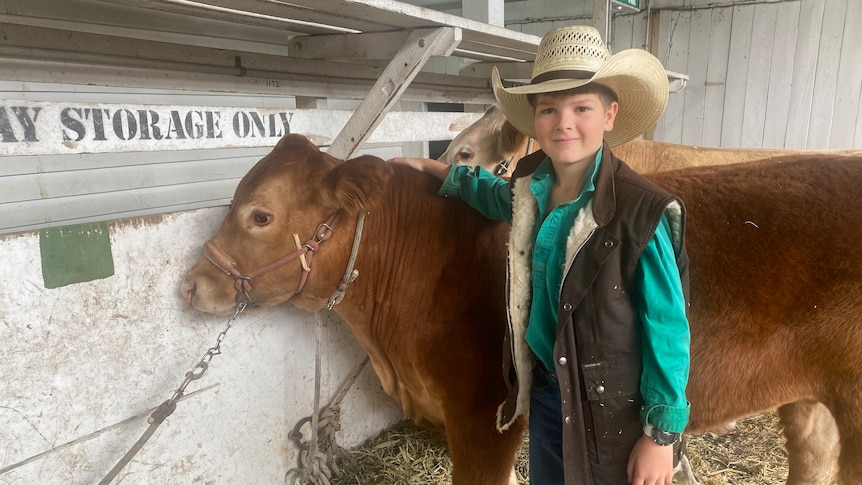Bull sales across New South Wales have exceeded expectations despite the looming threat of foot-and-mouth disease (FMD).
Key points:
- Bull prices for July sales are up about 20 per cent on last year
- A Gloucester-based stud sold its top bull this season for $190,000
- A new national record for the highest grossing single-vendor cattle sale – $5.8m – has been set at Warialda
Knowla Livestock, a stud based near Gloucester on the Mid North Coast, sold his top bull for $190,000 — the highest price paid nationally for a bull so far this season.
“It was unbelievable — $40,000 was our top price until this year, so we didn’t only break our own record, we absolutely smashed it,” principal James Laurie said.
The stud sold all of the 82 bulls it put to market for an average price of about $26,500.
Mr Laurie had been concerned sale prices would be adversely affected by the FMD outbreak in Indonesia.
Australia is ramping up biosecurity measures to prevent FMD from crossing the border, which would likely lead to mass culls of infected animals and cause major disruption to the meat and livestock trade.
The Australian Bureau of Agricultural and Resource Economics and Sciences (ABARES) estimates an outbreak could cost the country $80 billion over 10 years.
Mr Laurie said with FMD front of mind for many, he was not sure what kind of demand to expect at the sale.
“There’s a lot of uncertainty in the market at the moment, in both the physical market and from these overseas issues, so we were just thinking that might take the edge off it,” he said.
“But the interest we had that came from a lot further afield than what we’ve ever had before — that probably waylaid those fears.”
Prices up to 20 per cent
Auction Plus chief economist Tim McRae said the market had experienced a huge jump in prices for bulls compared with last year.
“For July we saw bull prices average 20 per cent above the same time last year — and prices were pretty high last year,” he said.
“But also the clearance rates [were high]so the number of bulls that have been getting sold per auction was well in the 90 per cent area.”
Mr McRae said the conditions over the last two years and rising cattle prices were behind the results.
“The very good seasonal conditions are enabling producers to make long-term decisions,” he said.
“There’s still pretty good confidence [in the industry]barring some of the recent downturns in the commercial market.
“The outlook for the beef industry is still very good and commercial producers are very keen to make sure the genetics they have help them optimize that in years to come.”
Struan Pearce of Stud Stock Sales agreed that concerns about FMD had not impacted sales.
“People are certainly aware of it,” he said.
“But I suppose they can’t just give up on it and concede defeat, so they’ve just got to keep moving forward, purchasing their bulls and new genetics and keep producing the steers that they’re earning their money from.”
Mr Pearce said prices were strong across the country.
“Geographically there’s been some terrific sales up in Queensland, right through NSW into Victoria and South Australia,” he said.
record smashed
Recently at Warialda, NSW, a new record was set for the highest grossing single-vendor sale of sheep or cattle in Australia when Texas Angus stud earned a remarkable $5.8 million for its bull and heifer sale.
Owners Ben and Wendy Mayne sold 209 bulls at an average price of $28,000.
“We were just hoping if we could get anywhere near the average of last year we’d be happy, but to go from an average price of $21,000 to $28,000 with an extra 40 bulls was surreal,” Mr Mayne said.
Ms Mayne believed the sale showed there was plenty of optimism about the future of the beef industry.
“The confidence at our sale was phenomenal and it was positive,” she said.
“There was no mention of any biosecurity issues on the day.
“We just believe we’ve had a little bit of a hiccup with biosecurity and things, but I think [industry confidence] only get stronger.”
.

